This Asian Thai Basil Pesto recipe is made with spinach, garlic, and ginger. It's combined with coconut milk to create a sauce for noodles!
If you like pesto, I think you'll love this version made with Thai basil. It's made with rice noodles and tossed in a creamy coconut milk sauce. This pesto puts an Asian spin on the classic!
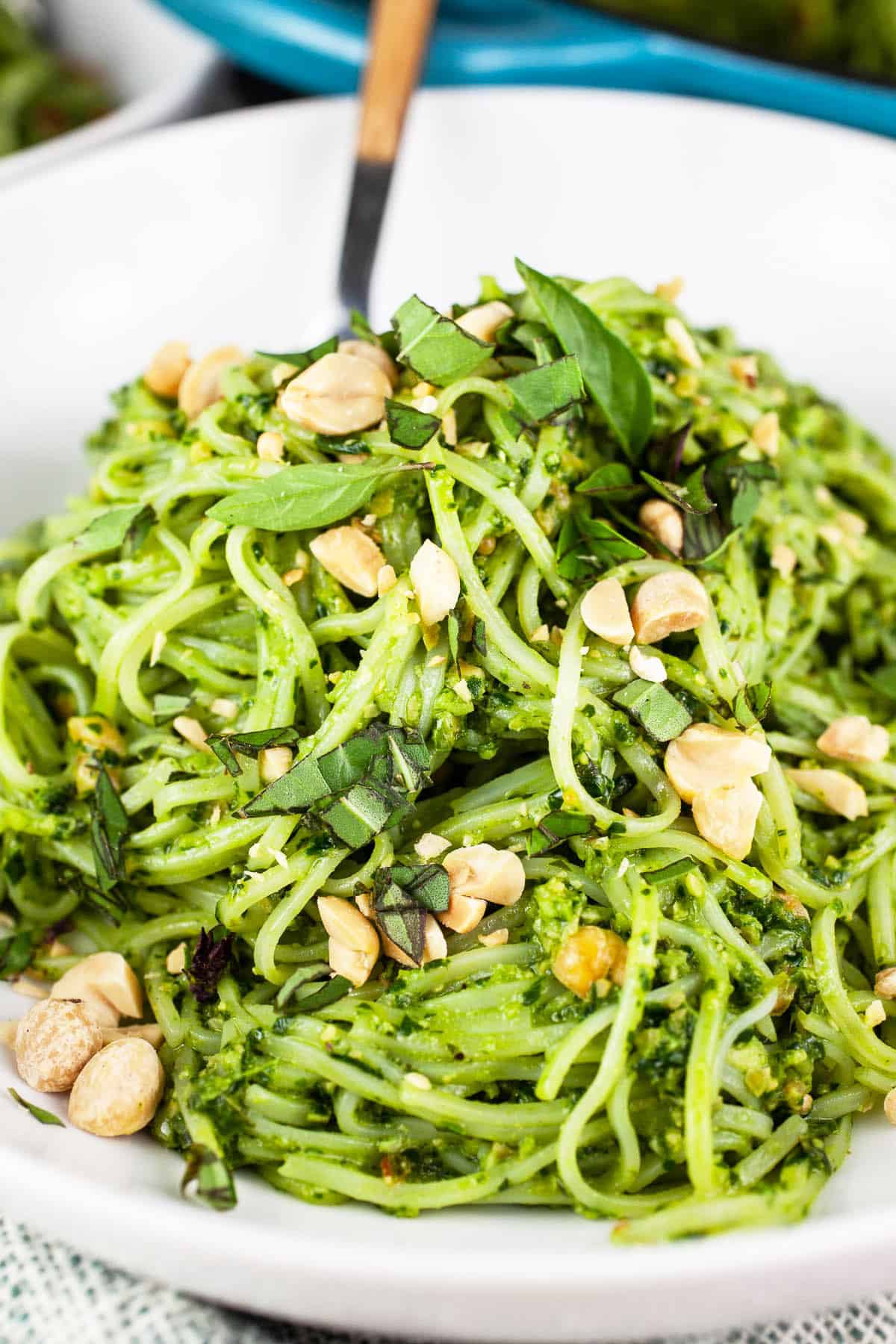
I love fresh herbs of all kinds, but my favorite might just be Thai basil. It's native to Southeast Asia and used extensively in cuisines from countries like Thailand, Vietnam, Cambodia, and Laos.
Thai basil has a distinct licorice flavor reminiscent of anise. It's savory, pungent, and has a few spicy notes. Thai basil is often found in dishes like pho, noodle bowls, curries, and salads.
Typically, when we think of the word pesto, Italian cuisine comes to mind. Pesto is often made with sweet basil and used in Italian cooking. This version is modeled after my Spinach Walnut Pesto and puts an Asian twist on it.
This pesto is made in the food processor and turned into a sauce, along with some vegetable broth and coconut milk. It's tossed with rice noodles for a super flavorful meal, which can be enjoyed on its own or topped with sautéed vegetables, meats, or seafood.
Jump to:
- What's The Difference Between Thai Basil and Regular Basil?
- Can I Use It In Place Of Sweet Basil?
- Where Can I Find Thai Basil?
- Ingredients For Thai Basil Pesto
- How To Roast Peanuts
- How To Make Pesto With Thai Basil
- What Is The Best Consistency For Pesto?
- How To Make Pesto Sauce For Noodles
- Which Noodles Are Best To Serve With Thai Pesto?
- What To Serve With Thai Pesto
- How Long Does Pesto Last In The Fridge?
- Can It Be Frozen?
- Thai Basil Pesto

What's The Difference Between Thai Basil and Regular Basil?
The type of basil most commonly grown in herb gardens and available in supermarkets across the United States is sweet basil (also known as Italian or Genovese basil).
Sweet basil is bright green in color, the leaves are oblong, and slightly pointed at the end. Its flavor is sweet and is commonly used in Italian and Mediterranean cuisines to make things like pesto, marinara sauce, and pasta.
Thai basil is used primarily in Southeast Asian cooking and is known for its distinctly aromatic anise flavor. Its leaves are more narrow than those of sweet basil and the stems of the herb are purple.
The leaves of Thai basil are sturdier than sweet basil leaves and stand up to cooking at high temperatures. Its flavor is bold and found in high heat dishes like stir fries, curries, and fried noodles.
Can I Use It In Place Of Sweet Basil?
I find that these two types of basil have distinctly different flavor profiles and generally would not recommend using one in place of the other.
You can use sweet basil instead of Thai basil to make Asian dishes like curry, but it's recommended that you combine it with fresh mint to help fill in those extra flavors.
Using Thai basil in place of sweet basil will alter the flavor too much and skew the overall dish. For example, using Thai basil in place of sweet basil when making marinara sauce will result in something other than marinara sauce.
Where Can I Find Thai Basil?
Thai basil can be purchased in the produce section of an Asian grocery store.
You can also grow it in your herb garden during the summer months. Thai basil is a hearty herb and easy to grow.
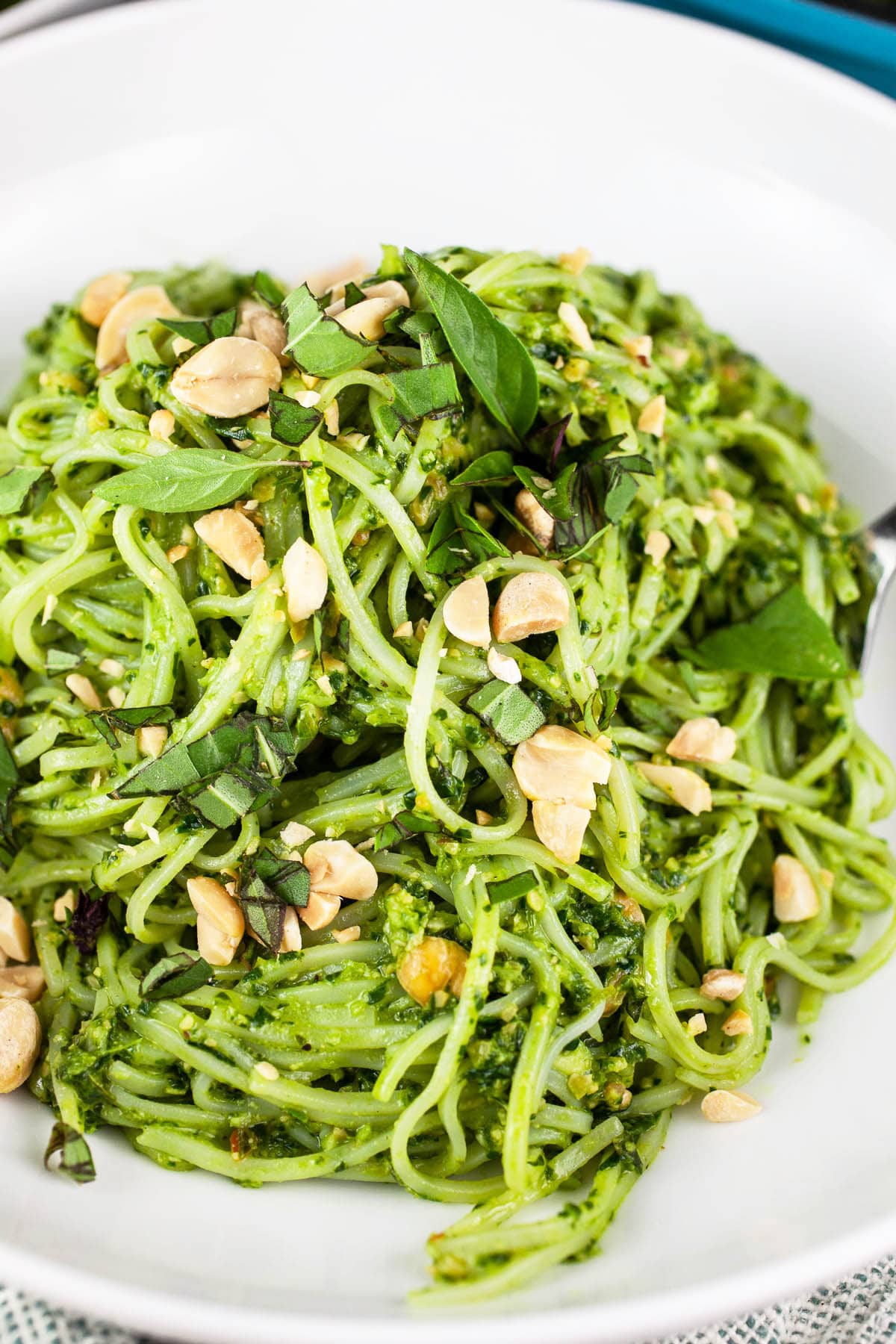
Ingredients For Thai Basil Pesto
This recipe consists of the pesto, which is made with a combination of fresh Thai basil and spinach.
It looks like a pasta dish that you might order at an Italian restaurant, but the flavors resemble that of one ordered from a Thai restaurant.
Here's what you'll need to make it.
- ½ cup Dry Roasted Peanuts (unsalted)
- 4 cloves Garlic
- 1 inch section Ginger Root (peeled)
- 1 Thai Chili (remove seeds for less heat)
- 1 Lime (Zest and Juice)
- 4 packed cups Fresh Spinach
- ½ packed cup Fresh Thai Basil
- ¼ cup Olive Oil
- ½ tsp. Kosher Salt
- ¼ tsp. Pepper
- ½ cup Vegetable Broth
- ½ cup Coconut Milk (full fat)
- 8 oz. package Stir Fry Rice Noodles
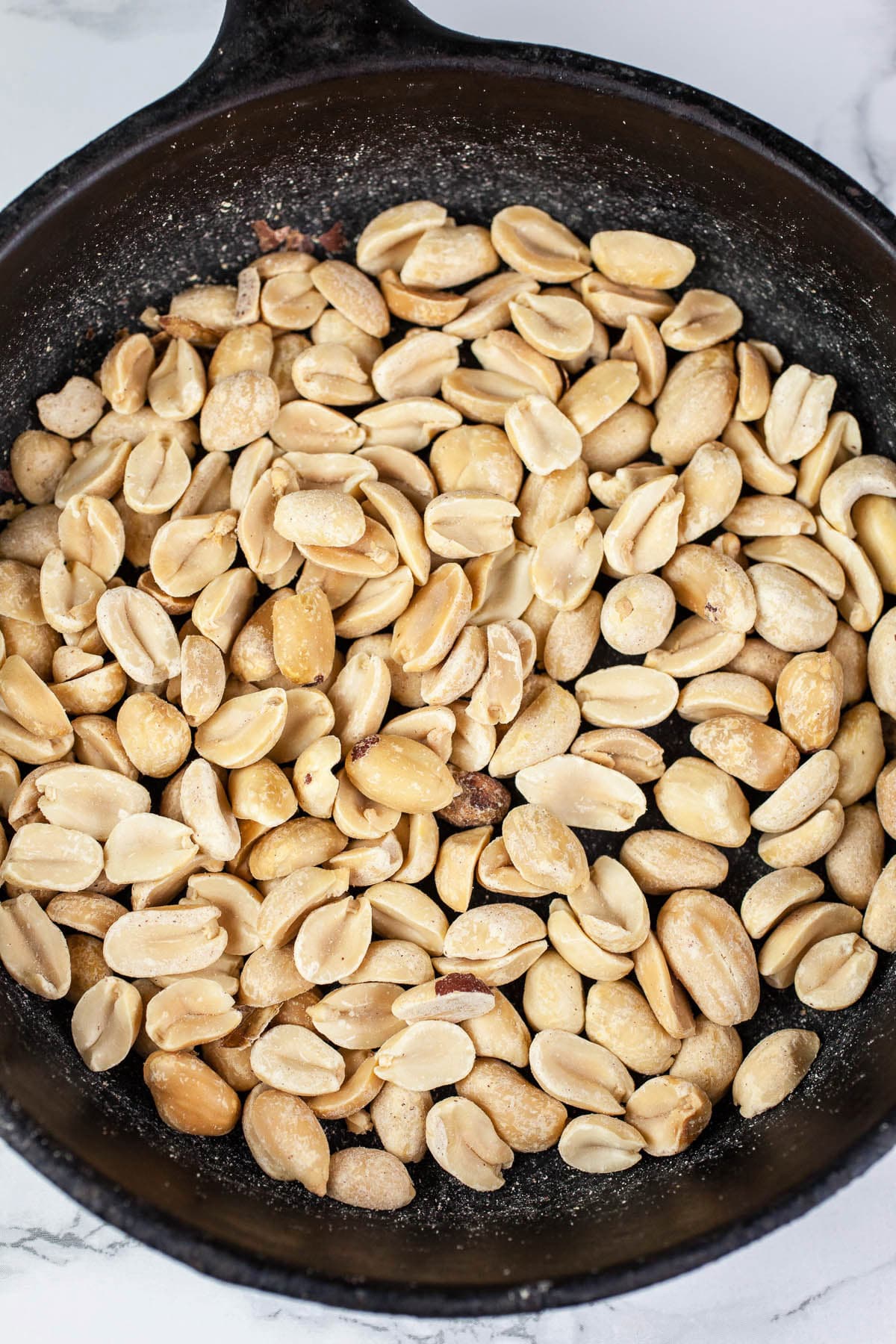
How To Roast Peanuts
Nuts are a quintessential ingredient found in pesto. Italian (or Genovese) pesto often uses pine nuts, but walnuts, almonds, or hazelnuts may also be used.
This Thai basil pesto uses peanuts (which is technically a legume and not a nut). Peanuts are often used in Southeast Asian cooking and used to add flavor and crunch to dishes like salads and stir fries.
The flavor of the peanuts lends itself nicely to that of the Thai basil.
I recommend using unsalted dry roasted peanuts when making this pesto. Peanuts that are already salted or seasoned will result in a dish that is way too salty.
Whenever I make a recipe that contains nuts or peanuts, I like to toast them before adding to the dish. Toasting the nuts helps to release their natural oils, resulting in a more robust flavor.
It only takes a few minutes and can be done on the stove top using a small skillet.
- To roast the peanuts, place a small skillet on the stove top and heat to medium-low. I like to use a small cast iron skillet, but any small skillet should be fine.
- Place ½ cup of unsalted dry roasted peanuts in the skillet and heat on medium-low for 6-8 minutes, stirring occasionally to prevent burning.
- Remove the skillet from the heat and set aside.

How To Make Pesto With Thai Basil
The process of making pesto with Thai basil is much the same of making it with sweet Italian basil. All of the ingredients are added to a food processor and pulsed until completely combined.
The ingredients used to make this version differ somewhat from those used to make Genovese pesto, but the concept is the same.
This recipe is made with both Thai basil and spinach. A pesto made entirely from Thai basil would be a bit overpowering. I find that adding spinach helps to balance out the strong flavors of the basil.
I have a small food processor and find that it works to make this pesto in batches. Half of the ingredients are added and pulsed until combined and then the process is repeated.
Feel free to make it in one batch if you have a large food processor.
- Peel 4 cloves of garlic and cut into chunks. There is no need to mince the garlic.
- Cut a 1-inch portion from a piece of ginger root. Remove the skin from the ginger root using a knife or a spoon. Cut the ginger root into chunks.
- Cut 1 Thai chili in half. Remove the seeds for less heat (the use of a Thai chili is optional). Feel free to leave it out if you prefer less spice.
- Add 2 packed cups of fresh spinach, ¼ packed cup of fresh Thai basil, 2 cloves garlic, half of the ginger root chunks, half of the Thai chili, ¼ cup of toasted peanuts, 2 Tbsp. olive oil, the zest from half a lime, ¼ tsp. kosher salt, and ⅛ tsp. pepper to a food processor. Pulse until completely combined.
- Repeat this process by adding the second half of each of these ingredients. Pulse until totally combined.

What Is The Best Consistency For Pesto?
This pesto is a bit 'drier' and chunkier than a traditional Italian pesto. It should be thick and slightly chunky when it has finished pulsing in the food processor.
It should be easily scooped with a spoon and not overly oily or runny.
Love pesto? Check out these recipes!
- Arugula Pesto Tomato Pizza
- Pesto Grilled Cheese
- Pesto Baked Cod and Potatoes
- Summer Pesto Pasta Salad
- Chicken Pesto Flatbread
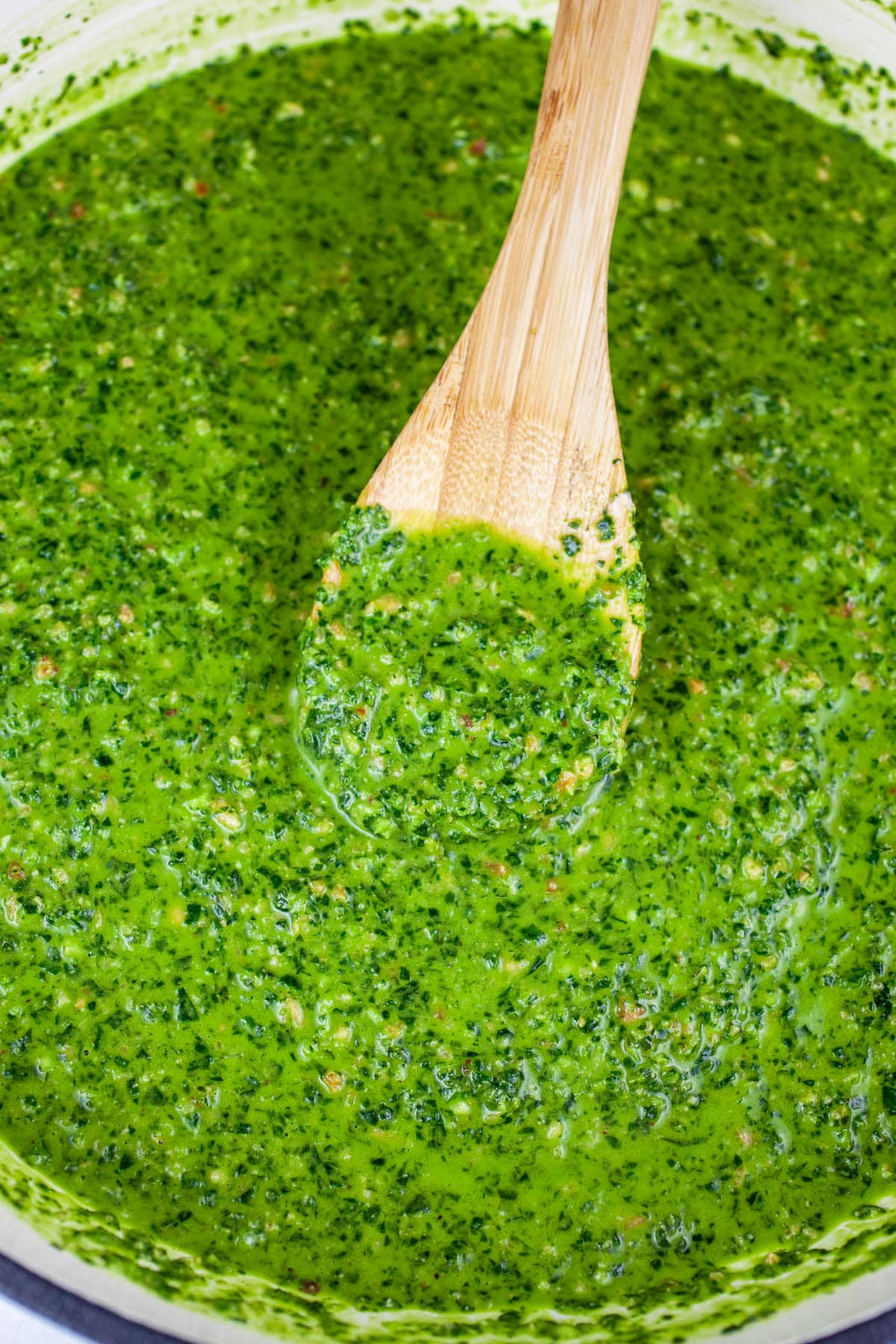
How To Make Pesto Sauce For Noodles
All of that pesto is then heated in a skillet, along with some vegetable broth, coconut milk, and lime juice.
The result is a luxurious and flavorful sauce that is perfect tossed with rice noodles.
- To make the sauce, place a skillet on the stove top and heat to medium.
- Add the Thai basil pesto and allow to heat slightly.
- Add ½ cup of vegetable broth (or chicken broth if not vegetarian), ½ cup full fat coconut milk, and the juice of the lime that was zested earlier. Allow the sauce to heat through.
- Stir until it has completely combined and reduce heat to keep it warm.
Feel free to add more broth or coconut milk if you would like to thin it out even more.

Which Noodles Are Best To Serve With Thai Pesto?
This pesto is full of Asian flavors, so I love to serve it with rice noodles. Rice noodles are strong and don't break apart when added to the sauce after cooked.
It's best to use a wide rice noodle like stir fry rice noodles and not thin rice noodles like vermicelli. A wide noodle is sturdier and doesn't easily become mushy. You can use white rice or brown rice noodles.
This recipe is gluten free, so rice noodles are a great choice. If you choose to use pasta noodles instead of rice noodles, be sure to opt for a quality brand that does not become mushy when cooked.
It's also important to cook the noodles just until al dente and then rinse them under cold water, so that they retain their texture.
- Make 1 package of rice noodles according to package instructions.
- Cook the noodles just until al dente.
- Drain the noodles in a colander and rinse them under cold water. This stops the cooking process.
- Transfer the cooked noodles into the skillet and toss until completely coated in the pesto sauce.

What To Serve With Thai Pesto
I love recipes like this one, because it is so versatile. It can be enjoyed as a meatless meal all on its own or garnished simply with some extra peanuts and Thai basil.
You can also top it with sautéed mushrooms, bell peppers, zucchini or summer squash.
Thai flavors pair really well with tofu. The tofu could be pan seared, roasted, or grilled.
It's perfect with some sautéed shrimp, salmon, or any kind of seafood.
Pesto noodles are delicious with grilled or roasted chicken breasts.
You can also serve this pesto just as a sauce and use it to drizzle over your favorite grilled vegetables, meats, or seafood.
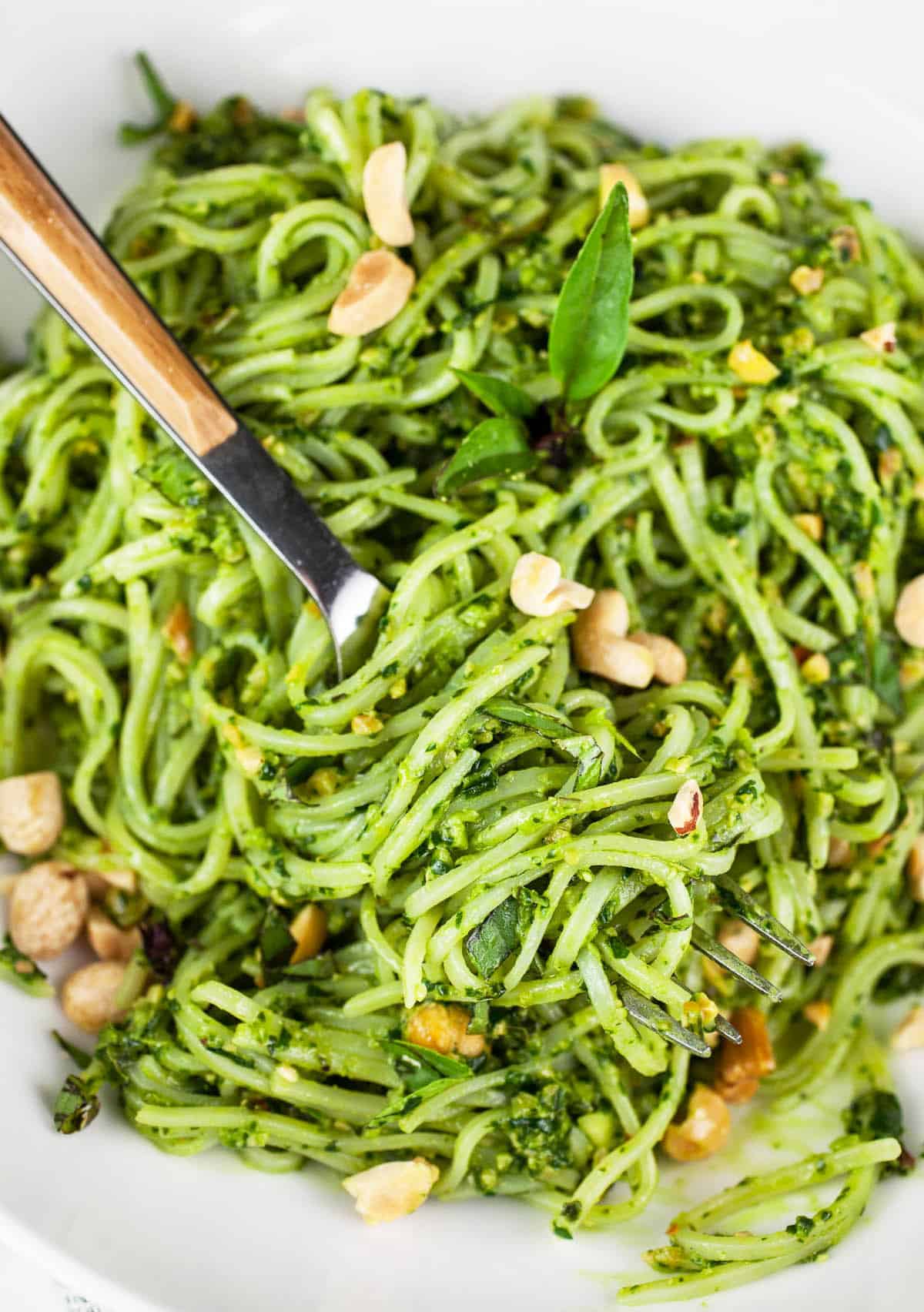
How Long Does Pesto Last In The Fridge?
This pesto tossed with pasta should last 2-3 days stored in an airtight container in the fridge.
Feel free to store the pesto (not pesto sauce) in an airtight container for 3-4 days in the fridge and use as needed.
Be sure to warm the sauce up before serving, as the coconut milk is likely to solidify in the fridge.
Feel free to add some water or broth to the noodles if reheating.
Can It Be Frozen?
This pesto sauce is best enjoyed fresh and I do not recommend freezing it.
If you love pesto, be sure to check out this Spinach Walnut Pesto and Green Pasta Sauce!
Love Asian flavors? Check out these recipes!
- Vietnamese Shrimp Noodle Salad
- Smoked Salmon Rice Bowl
- Korean Turkey Bowls
- Teriyaki Turkey Rice Bowls
- Maple Sesame Brussels Sprouts
- Thai Chicken Rice Bowls
- Sweet and Spicy Brussels Sprouts
- Thai Style Potato Corn Chowder
- Crockpot Teriyaki Meatballs
Looking For More Thai Basil Recipes? Don't Miss These!
Thai Risotto
Thai Basil Chicken
Thai Basil Tofu Stir Fry
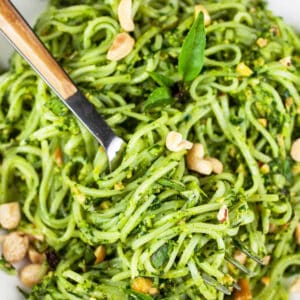
Thai Basil Pesto
Equipment
- Food Processor
Ingredients
For The Pesto:
- ½ cup dry roasted peanuts unsalted
- 4 cloves garlic
- 1 inch ginger root peeled
- 1 Thai chili seeds removed
- 4 packed cups fresh spinach
- ½ packed cup Thai basil leaves
- ¼ cup olive oil
- lime zest
- ½ tsp. kosher salt
- ¼ tsp. pepper
For The Sauce:
- ½ cup vegetable broth or chicken broth if not vegetarian
- ½ cup coconut milk full fat
- 2 Tbsp. lime juice equals 1 large lime
- 8 oz. stir fry rice noodles white or brown
Instructions
- Prepare 1 8 oz. package of stir fry rice noodles (white or brown) according to package instructions. Cook the noodles just until al dente and then place them in a colander to drain. Run the noodles under cold water to stop the cooking process. This will prevent them from becoming mushy.
For The Pesto:
- Place a small skillet (I love to use a small cast iron skillet) on the stove top and heat to medium-low.
- Place ½ cup of unsalted dry roasted peanuts in the skillet. Toast the peanuts on medium-low for 6-8 minutes, stirring occasionally to prevent the peanuts from burning. Remove from heat and set aside.
- Remove the skin from 4 cloves of garlic and cut into chunks.
- Cut a 1-inch portion from a piece of ginger root. Remove the skin from the ginger root using a knife or a spoon. Cut the ginger root into chunks.
- Cut 1 Thai chili in half and remove the seeds for less heat. Cut the chili into chunks. (Wear plastic gloves to prevent 'hot pepper hands') and be careful not to touch your eyes afterward.Alternately, you can leave the Thai chili out entirely if you do not care for spice.
- Add 2 packed cups of fresh spinach, ¼ packed cup of fresh Thai basil leaves, 2 cloves garlic, half of the ginger root chunks, half of the Thai chili, ¼ cup of toasted peanuts, 2 Tbsp. olive oil, the zest from half a lime (the lime may be zested using a Microplane or small zester), ¼ tsp. kosher salt, and ⅛ tsp. pepper to a food processor. Pulse until completely combined.
- Repeat this process by adding the second half of each of these ingredients. Pulse until totally combined.If you have a large food processor, you can complete this step in one batch instead of two.
For The Sauce:
- Place a skillet on the stove top and heat to medium.
- Add the Thai basil pesto and allow to heat through, stirring as it heats.
- Add ½ cup of vegetable broth (or chicken broth if not vegetarian), ½ cup full fat coconut milk, and the juice of the lime that was zested earlier (equals 2 Tbsp. lime juice). Stir the sauce until combined and allow to heat through.
- Add the cooled, rinsed rice noodles to the skillet and toss in the sauce until completely coated.Feel free to add more broth if you'd like to thin out the sauce. Or, you can add a bit more coconut milk for a more decadent sauce.
- To Serve: Place the pesto coated rice noodles in a bowl. Top with extra peanuts, minced Thai basil, and some extra lime zest (optional). See copy above for more serving ideas.




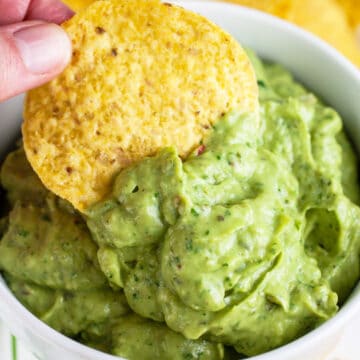
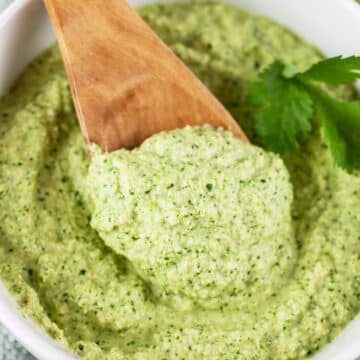
Leave a Reply